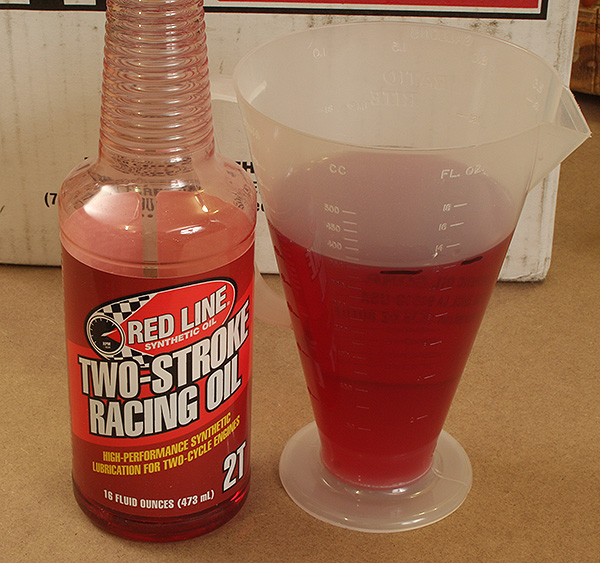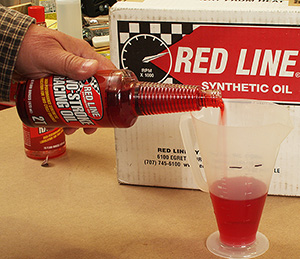



Red Line oil is so effective engine break-in can take much longer than expected
because wear is so greatly reduced.
Text and photos by Tom Hintz
Posted – 2-8-2015
One of the major benefits of using modern synthetic 2-stroke oils is their efficiency that allows a dramatically higher ratio of gas to the oil. Where 30 and 32 parts gas to 1 part oil (32:1) was common synthetic oils are frequently used at ratios of 50 parts gas to 1 part oil (50:1) and even 100 parts gas to 1 part oil (100:1) are common. I and many others still use the 32 to 1 ratio with premium 2-cycle fossil-based oils for breaking a motor in per the manufacturer’s directions but I can find nothing that says synthetics will not do the job as well or even better.
Oils such as the highly popular Red Line Two-Stroke Racing Oil possess tremendous protective capabilities along with lubrication properties that can extract a little more horsepower and RPM from an engine by reducing friction. Red Line literature claims that they have performed dyno testing that shows gains of 3-5% and more horsepower over longer runs.
The high-temperature stability of the Red Line Two-Stroke Racing Oil and the high mixing ratios we use translate to dramatically reduced deposits on combustion chambers, exhaust ports, upper ring, and piston tops. Red Line Two-Stroke Racing Oil is a totally synthetic ester formula that is responsible for the reduced friction along with very good high RPM protection in part because of superior film strength on hot metals. Red Line Two-Stroke Racing Oil also has a high detergency feature which helps reduce carbon build-up on spark plugs and other in-cylinder components. While Red Line Two-Stroke Racing Oil lubricates better than the traditional castor oils the exhaust is much cleaner in terms of what it leaves on the plane.
Along with all its other properties Red Line Two-Stroke Racing Oil has anti-scuff additives that among other things helps protect from sticky rings in high temperature situations. That also reduces overall cylinder and bearing wear.
When I started using Red Line Two-Stroke Racing Oil at 50:1 I had to tweak the carbs on my engines. I had to lean them slightly which makes sense because in the same volume the engine is seeing more gas and less oil. With the carb adjusted for the Red Line Two-Stroke Racing Oil mix the settings seem to be holding very well with no further tweaking needed after a few weeks of flying.
One little bit of concern came after burning a few tanks of the Red Line Two-Stroke Racing Oil mix. I noticed a very dark, nearly black residue coming from the exhaust pipes and onto nearby plane surfaces. That slowly went away which leads me to believe the Red Line Two-Stroke Racing Oil was “cleaning” the inside of the motor and mufflers. I had run all my engines very rich during the first weeks of break-in, then slightly rich from there on out using petroleum-based oils. Red Line says their oil will help remove internal deposits and that sure seems to be true with my engines.
Overall the change to the Red Line Two-Stroke Racing Oil 50:1 mixture has been easy. My planes are running nice and they are staying cleaner. I can’t say that I have noticed much difference in temperatures, judged only by how they are running. I do see more RPM and horsepower, particularly noticeable in vertical performance. The engines just seem to pull harder with the same props on the Red Line Two-Stroke Racing Oil mix.
Using the Red Line Two-Stroke Racing Oil is surprisingly cheap also. Keep in mind that a 50:1 mix takes 12oz of Red Line Two-Stroke Racing Oil per 5 gallons of gasoline. I see 16oz bottles selling for $10.95 (2-8-2015) and you can usually save little more by purchasing a case of 12 bottles which is what I did. I use enough fuel over a season that I am not worried about shelf life of the Red Line Two-Stroke Racing Oil which I suspect is far longer than matters to most of us.

I have a DLE 40-Twin that has run so well
for so long on the Red Line Oil it is
beginning to scare me. I have to resist
sending the engine in just to see if it
really is in such good shape after so many
hours of operation.
Virtually all of the feedback I have gotten from other fliers on the Red Line Two-Stroke Racing Oil is confirmed by my own experience with it. Red Line Two-Stroke Racing Oil does a great job of protecting our gas engines which extends their life and reduces our operating costs. It is also nice to just gas the planes up and go fly. In the words of some 60’s era big thinker, the engines just “keep on keeping on”. Corny or not I like it when a product has that kind of positive impact on my flying while reducing the cost of keeping my planes in the air.
Visit the Red Line Two-Stroke Racing Oil web page – Click Here
Have a comment on this review? - Email Me!